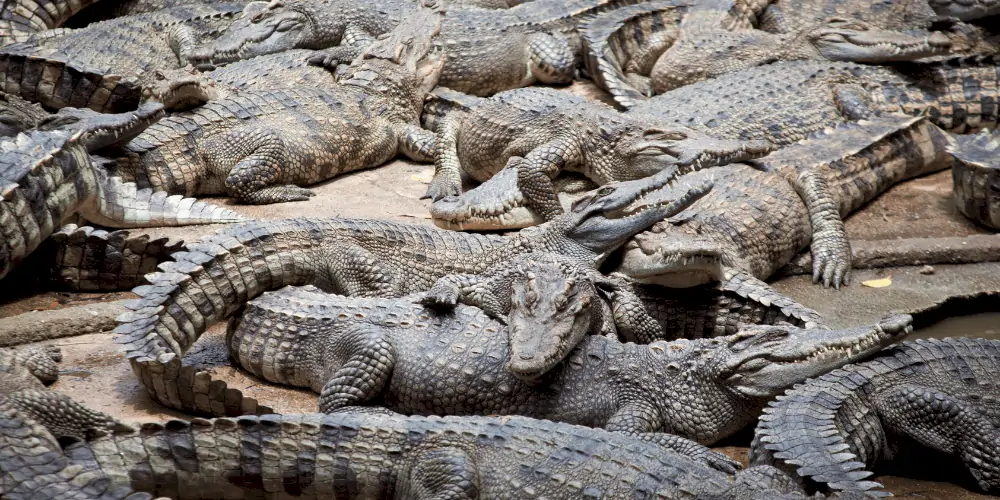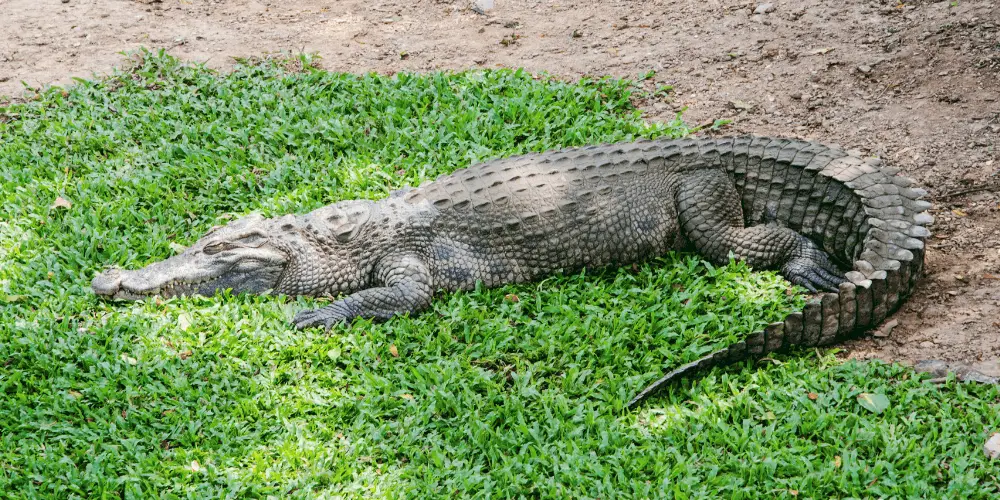Crocodiles are apex predators with razor-sharp teeth adapted for hunting and consuming prey.
But how many teeth does a crocodile have?
Crocodiles’ teeth vary depending on the species. Saltwater crocodiles have 60-66. Nile crocodiles have 64-68. Mugger crocodiles have 40-48. American crocodiles have 64-66. They are polyphyodonts, meaning they replace each tooth up to 50 times in their 35-75 year life.
This article will explore crocodile tooth anatomy, differences in tooth count, and other fascinating facts about these iconic creatures’ chompers.
Key Takeaways
- Crocodile teeth vary depending on species, with 64-68 being typical for Nile crocodiles.
- Their teeth are differentiated into incisors, canines, premolars, and molars to hunt different prey effectively.
- Crocodiles continuously replace their teeth throughout their lifespan, shedding old ones as new teeth grow.
- Younger crocodiles replace teeth more frequently, while older ones may take years to replace a single tooth.
- With an estimated lifetime total of 2,000-3,000 teeth, crocodiles have the strongest bite force of any animal at over 3,700 psi.
Crocodile Tooth Anatomy
Crocodiles have heterodont dentition, meaning their teeth are differentiated into distinct types and shapes.
Their teeth are conical and sharply pointed, suited for puncturing, holding, and tearing apart prey. The four basic types of crocodile teeth are:
- Incisors – At the front of the mouth, used for initial piercing of prey.
- Canines – Long, sharp teeth next to the incisors used for grasping and holding prey.
- Premolars – Behind the canines, these teeth have cusps for tearing flesh.
- Molars – Broad, blunt teeth at the back of the mouth for crushing bones and shells.
This variety of tooth types allows crocodiles to hunt and consume different prey effectively.
The pointed incisors and canines penetrate flesh and grip victims, while the ridged premolars and flattened molars are ideal for ripping apart meat and crunching bones.
Crocodile teeth are also specially adapted to their aquatic lifestyle. The enamel coating is very hard and resistant to abrasion, protecting the teeth from damage when biting through bone, turtle shells, or other hard materials.
And unlike human teeth, crocodile teeth are continually replaced throughout their lifetime.
Damaged or lost teeth are shed and replaced by new ones growing in the dental lamina behind existing teeth. This regeneration allows crocodiles to maintain functional dentition as teeth wear down from use.
Variation in Tooth Count
While all crocodile species share the same basic heterodont tooth structure, the number of teeth varies significantly between different types of crocodiles.
This diversity reflects the range of prey items crocodiles have adapted to eat. Some examples of tooth counts in major crocodile species:
- Dwarf crocodile – Around 60 total teeth
- Gharial – 110-120 teeth
- Saltwater crocodile – 66 total teeth, with 18 teeth on the upper jaw and 15 on the lower jaw, applies specifically to mature males. Females tend to have slightly fewer teeth.
- Nile crocodile – Usually 64-68 teeth
- Mugger crocodile – 40-48 teeth generally
So while individual species have a typical number of teeth, there can still be considerable variation within those ranges based on the size and age of a particular crocodile.
Older, larger crocodiles tend to have more teeth than younger juveniles. Diet and habitat may also influence tooth counts.
Lifespan of Crocodile Teeth
Due to their continuous tooth replacement, crocodiles go through numerous teeth over their long lifespans.
They are estimated to use 2,000 to 3,000 teeth throughout their lives!
Crocodile teeth are constantly being shed and replaced. A new tooth grows in the dental lamina behind the existing functional tooth.
Once mature, the new tooth pushes out the old, worn tooth, which is shed. Tooth replacement occurs gradually over time.
Unlike sharks that shed many teeth at once, crocodiles usually only replace one or two teeth at a time.
This ensures they maintain enough functional teeth to keep hunting and feeding.
The tooth replacement rate depends on diet, habitat, and age.
More frequent biting of hard materials like bone accelerates tooth wear and requires faster replacement.
Younger, growing crocodiles may replace teeth more often as the jaws lengthen.
Crocodile Feeding Habits
The variety of tooth types and sheer number of teeth allow crocodiles to be flexible, opportunistic predators.
Their teeth are well-suited to capturing and consuming a diverse range of prey.
Crocodiles are ambush hunters, waiting patiently in the water for unsuspecting land animals to approach before attacking.
The sharp conical teeth pierce prey, while the jagged edges of canines and carnassials inflict deep lacerations and grip flesh.
Powerful head shaking further tears prey apart. They swallow chunks of meat whole, sometimes twisting and rolling to break the food into smaller pieces that can be consumed.
The broad molar teeth at the back of the mouth provide crushing force to break apart bones, shells, and other hard materials that are also consumed.
In addition to active hunting, crocodiles scavenge opportunistically, using their teeth to slice open carcasses and consume decaying meat.
Their immune systems protect them from toxins produced by rotting flesh.
Nile Crocodile vs. Alligator Teeth Differences
Here is a comparison of Nile Crocodile and Alligator teeth using a table:
| Feature | Nile Crocodile | Alligator |
|---|---|---|
| Number of teeth | 64-68 teeth | 74-80 teeth (American Alligator) |
| Tooth shape | Conical, sharp, and evenly spaced | Conical, blunt |
| Jaw shape | Narrower, V-shaped snout | Broader, U-shaped snout |
| Tooth replacement | Polyphyodont (replaces teeth) | Polyphyodont (replaces teeth) |
| Hunting | Ambush predator | Ambush predator |
The Nile crocodile has slightly fewer teeth on average than an American alligator, with 64-68 teeth compared to 74-80 teeth.
Both have a similar heterodont dentition adapted for crushing, gripping, and tearing apart prey.
However, the Nile crocodile’s teeth tend to be more sharply pointed, while the alligator’s teeth are blunter.
Crocodile Teeth Interesting Facts
- Salinity tolerance allows crocodiles like saltwater crocodiles to inhabit marine environments. Special glands near the tongue secrete excess salt to compensate for saltwater ingestion.
- The crocodile’s fourth tooth on the lower jaw fits into a notch in the upper jaw. This allows the upper and lower jaws to interlock when biting down on prey.
- Crocodiles have the strongest bite force ever measured in the animal kingdom. Large crocodiles can slam their jaws shut with a force exceeding 3,700 pounds per square inch.
- Their teeth are constantly replaced, but crocodiles can go through thousands of teeth over a lifetime. Individual teeth are shed and replaced gradually over time.
- The conical shape and jagged edges of crocodile teeth make them effective at piercing prey, inflicting deep wounds, and maintaining a strong grip.
- Tooth loss is rare in crocodiles since replacement teeth grow in the dental lamina behind functional teeth. Damaged teeth are quickly replaced.
- Diet influences tooth structure. Crocodiles that eat more fish have slender, needle-like teeth while those eating mammals have broader teeth.
- Fossil evidence shows the basic form of crocodilian teeth has remained unchanged for over 200 million years.
Final Thoughts
Crocodiles possess a variety of specialized teeth that make them formidable aquatic predators.
While all species have conical, serrated teeth, the number of teeth varies from 60 to 100 depending on the species.
These teeth are constantly replaced throughout a crocodile’s long lifetime, with an estimated 2,000 to 3,000 teeth grown over many years.
Their powerful, vice-like jaws deliver an immense bite force, allowing crocodiles to utilize their rugged teeth for hunting and eating fully.
The next time you see a crocodile snap its jaws remember that those menacing chompers are ruthlessly effective, incredibly strong, and perpetually renewable!
REFERENCES:
- Crocodile. (2023, August 29). In Wikipedia. https://en.wikipedia.org/wiki/Crocodile
- Britannica. (2023, August 11). Crocodile | Habitat, Description, Teeth, & Facts. Retrieved from https://www.britannica.com/animal/crocodile-order
- Nile Crocodiles (Crocodylus niloticus & C. suchus) Fact Sheet: Behavior & Ecology. (2023, May 16). Retrieved from https://ielc.libguides.com/sdzg/factsheets/nile_crocodile/behavior
- NCBI. (2019, February 28). Quantitative heterodonty in Crocodylia: assessing size and shape across modern and extinct taxa. Retrieved from https://www.ncbi.nlm.nih.gov/pmc/articles/PMC6397764/
- Crocodile Specialist Group. (2023, January 1). The Crocodilian Body. Retrieved from https://www.iucncsg.org/pages/The-Crocodilian-Body.html



